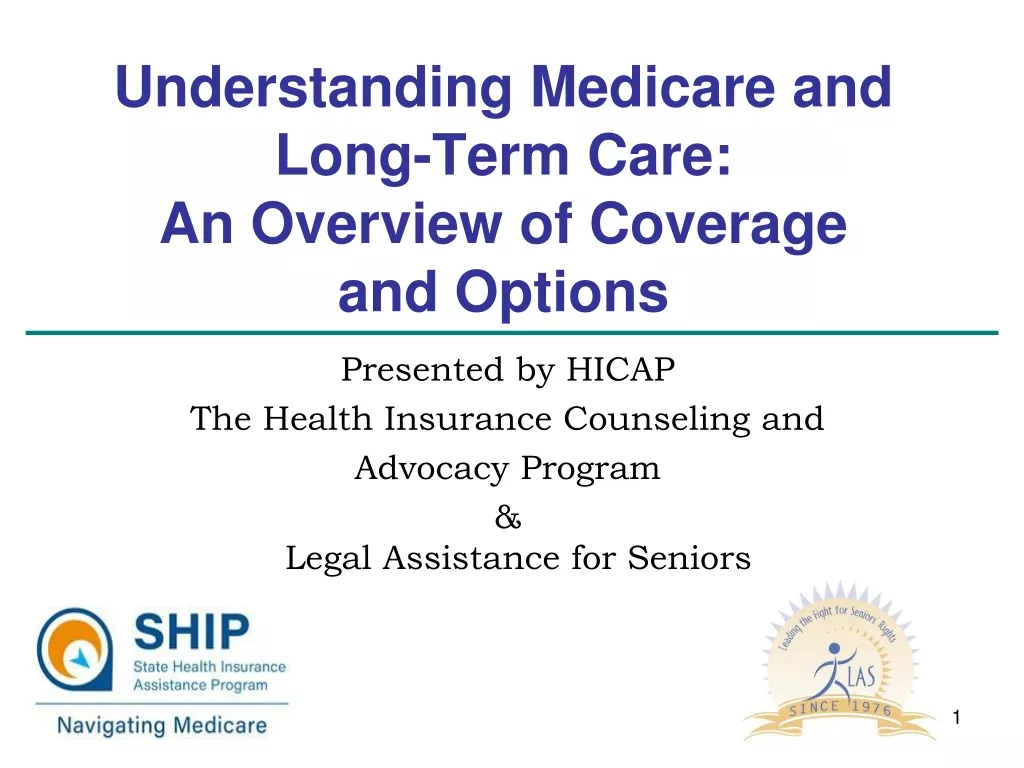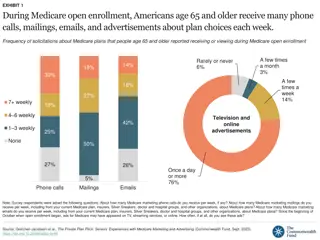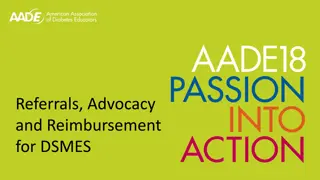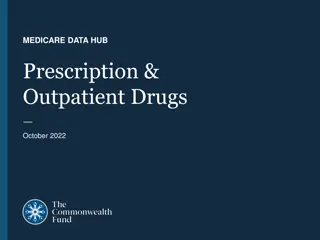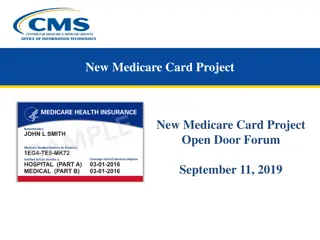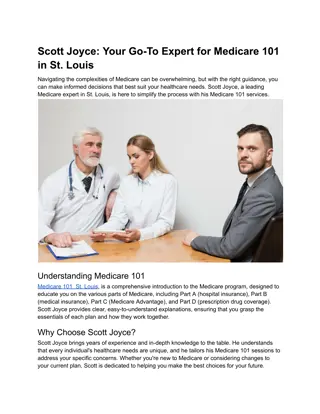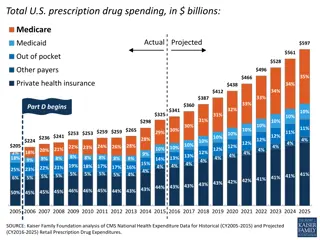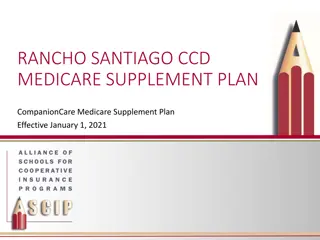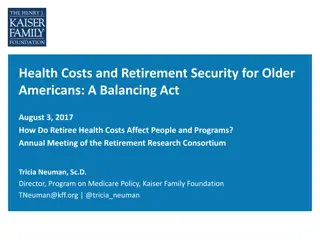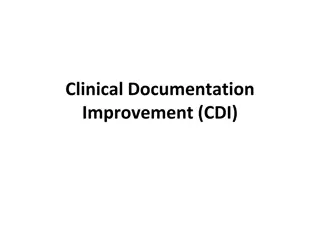Medicare Beneficiary Identification Initiative Overview
The Social Security Number Removal Initiative (SSNRI) aims to enhance Medicare beneficiary protection by replacing SSN-based Health Insurance Claim Numbers with new Medicare Beneficiary Identifiers (MBIs). This initiative mandates the issuance of redesigned Medicare cards by April 2019, minimizing identity theft risks and ensuring smoother operations for beneficiaries, providers, and Medicare systems. Complex IT system changes are underway to accommodate this transition while engaging stakeholders for successful implementation.
Download Presentation

Please find below an Image/Link to download the presentation.
The content on the website is provided AS IS for your information and personal use only. It may not be sold, licensed, or shared on other websites without obtaining consent from the author.If you encounter any issues during the download, it is possible that the publisher has removed the file from their server.
You are allowed to download the files provided on this website for personal or commercial use, subject to the condition that they are used lawfully. All files are the property of their respective owners.
The content on the website is provided AS IS for your information and personal use only. It may not be sold, licensed, or shared on other websites without obtaining consent from the author.
E N D
Presentation Transcript
Social Security Number Removal Initiative (SSNRI) Open Door Forum 03/28/17
Background The Health Insurance Claim Number (HICN) is a Medicare beneficiary s identification number, used for paying claims and for determining eligibility for services across multiple entities (e.g. Social Security Administration (SSA), Railroad Retirement Board (RRB), States,Medicare providers and health plans,etc.) The Medicare Access and CHIP Reauthorization Act (MACRA) of 2015 mandates the removal of the Social Security Number (SSN)-based HICN from Medicare cards to address current risk of beneficiary medicalidentity theft The legislation requires that CMS mail out new Medicare cards with a new Medicare Beneficiary Identifier (MBI) by April2019 2
SSNRI Program Goals Primary goal: To decrease Medicare Beneficiary vulnerability to identity theft by removing the SSN-based HICN from their Medicareidentification cards and replacing the HICN with a new Medicare Beneficiary Identifier (MBI) In achieving this goal CMS seeksto: Minimize burdens for beneficiaries Minimize burdens forproviders Minimize disruption to Medicareoperations Provide a solution to our business partners that allows usage ofHICN and/or MBI for business critical dataexchanges Manage the cost, scope, and schedule for theproject 3
Complex IT Systems affecting Providers, Partners, and Beneficiaries Along with our partners, CMS will address complex systems changesfor over 75 systems, conduct extensive outreach & education activities and analyze the many changes that will be needed to systems and business processes Affected stakeholdersinclude: Federal partners, States, Beneficiaries, Providers, andPlans Other key stakeholders, such as billing agencies, advocacy groups,data warehouses,etc. CMS has been working closely with partners and stakeholdersto implement the SSN RemovalInitiative 4
Solution Concept: Medicare Beneficiary Identifier (MBI) The solution for SSNRI must provide the followingcapabilities: 1. Generate MBIs for all beneficiaries: Includes existing (currently active, deceased or archived) and new beneficiaries 2. Issue new, redesigned Medicare cards: New cards containing theMBI to existing and new beneficiaries 3. Modify systems and business processes: Required updatesto accommodate receipt, transmission, display, and processing of the MBI CMS will use a MBI generatorto: Assign 150 million MBIs in the initial enumeration (60 million active and90 million deceased/archived) and generate a unique MBI for each new Medicarebeneficiary Generate a new unique MBI for a Medicare beneficiary whose identityhas been compromised 6
HICN and MBI Number Health Insurance Claim Number(HICN) Primary Beneficiary Account Holder Social Security Number (SSN) plus Beneficiary Identification Code (BIC) 9-byte SSN plus 1 or 2-byteBIC Key positions 1-9 arenumeric Note: Identifiers are fictitious and dashes for display purposes only; they are not stored in the database nor used in file formats Medicare Beneficiary Identifier(MBI) New Non-Intelligent UniqueIdentifier 11bytes Key positions 2, 5, 8, and 9 will alwaysbe alphabetic 7
MBI Characteristics The Medicare Beneficiary Identifier will have the following characteristics: The same number of characters as the current HICN (11), but will be visibly distinguishable from the HICN Contain uppercase alphabetic and numeric characters throughout the 11 digit identifier Occupy the same field as the HICN on transactions Be unique to each beneficiary (e.g. husband and wife will have their own MBI) Be easy to read and limit the possibility of letters being interpreted as numbers (e.g. Alphabetic characters are upper case only and will exclude S, L, O, I, B, Z) Not contain any embedded intelligence or special characters Not contain inappropriate combinations of numbers or strings that may be offensive CMS anticipates that the MBI will not be changed for an individual unless the MBI is compromised or other limited circumstances still undergoing review 8
SSNRI Transition Periods CMS will complete its system and process updates to be ready toaccept and return the MBI on April 1,2018 All stakeholders who submit or receive transactions containing the HICN must modify their processes and systems to be ready to submit orexchange the MBI by April 1, 2018. Stakeholders may submit either the MBI or HICN during the transitionperiod CMS will accept, use for processing and return to stakeholders eitherthe MBI or HICN, whichever is submitted, during the transitionperiod In addition, beginning October 2018 through the end of the transition period, when a valid and active HICN is submitted on Medicare fee-for-service claims both the HICN and the MBI will be returned on the remittance advice The transition period will run from April 2018 through December 31,2019 10
SSNRI Exceptions After the Transition Period Once the transition period is over, you ll still be able to use the HICN in these situations: 1. Appeals Use the HICN for appeals where you originally submitted a HICN on the claim 2. Reports Incoming Reports to CMS* (i.e., quality reporting, Disproportionate Hospital data requests) Outgoing Reports from CMS (i.e., Provider Statistical & Reimbursement Report, Accountable Care Organization Reports) 3. Retroactive enrollments 4. Span-date claims 11X-Inpatient Hospital, 32X-Home Health and 41X-Religious Non-Medical Health Care Institution claims with a From Date prior to the end of the transition period (12/31/19) 5. Adjustments Use the HICN for adjustments where you originally submitted a HICN on the claim (i.e. PDE, Risk Adjustment and Encounter data) 6. Incoming information requests 7. Incoming premium payments *note: we ll use the HICN on these reports until further notice 11
SSNRI Card Issuance CMS will begin issuing new Medicare cards for existing beneficiariesafter the initial enumeration of MBIs; roughly 60 millionbeneficiaries The gender and signature line will be removed from the new Medicarecards The Railroad Retirement Board who will issue their new cards toRRB beneficiaries We will continue to work with states that currently include the HICN on Medicaidcards to remove the Medicare ID or replace it with aMBI CMS will conduct intensive education and outreach to allMedicare beneficiaries and their agents to help prepare for thischange 12
Outreach and Education CMS will provide outreach and educationto: Approximately 60 million beneficiaries, their agents, advocacy groups andcaregivers HealthPlans The provider community (1.5Mproviders) States andTerritories Key stakeholders, vendors & otherpartners CMS will continue to ensure that we involve all stakeholders in our outreach and education efforts through their existing vehicles for communication(e.g. Open Door Forums, HPMS notices,etc.) 13
Operational Communications You can find out operational information on SSNRI from the following areas: Open Door Forums - Held Quarterly July 27, 2016 November 1, 2016 January 17, 2017 (COBA and MSP) Upcoming March 28, 2017 Industry Conferences Workgroup for Electronic Data Interchange (WEDI) Healthcare Information and Management Systems Society (HIMSS) National Association for Rural Health Clinics (NARCH) Medicaid Enterprise Systems Conference (MESC) Healthcare Billing Manager Association (HBMA) Current communications with CMS (HPMS notices, email blasts, etc.) CMS.gov website: http://go.cms.gov/ssnri 14
What do I need to do? 1. Participate in our Open Door Forums when possible 2. Obtain technical information on SSNRI from your regular communication channels 3. Check our SSNRI website for updated information: http://go.cms.gov/ssnri 15
FinalThoughts Thank you for participating in this discussiontoday Please submit any additional information to the SSNRI team mailboxat: SSNRemoval@cms.hhs.gov 16



